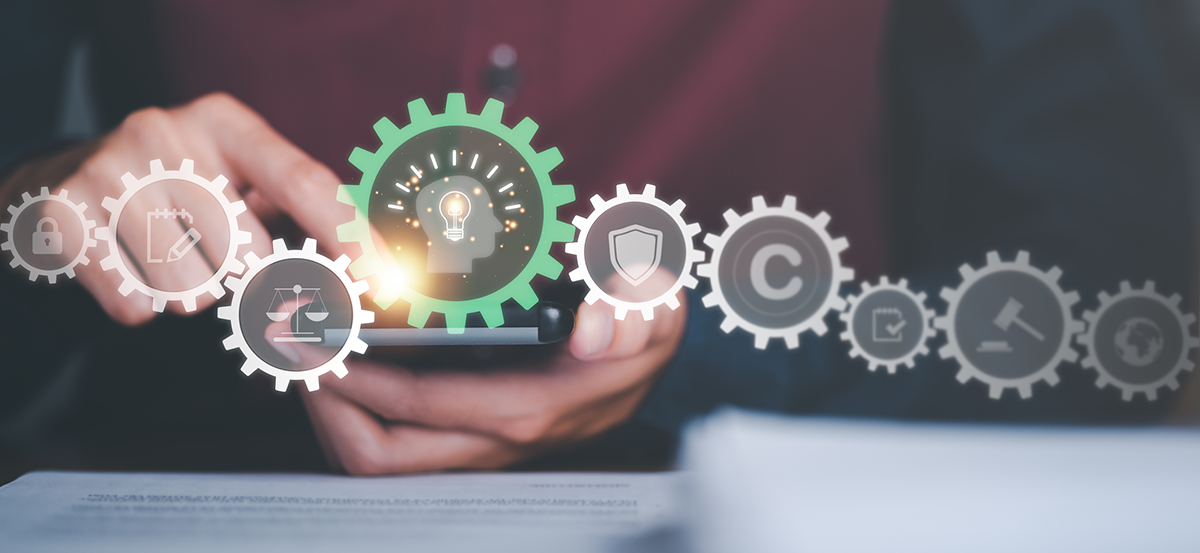
By Nate Louwagie and Seung Sub (Elvis) Kim
The last year has brought several significant changes to patent law. This article outlines five updates that lawyers should keep in mind when advising their business clients.
Two Federal Circuit Cases Provide Guideposts for Fact-Intensive Inventorship Inquiry
When multiple people work together on inventions, they are “joint inventors” with equal rights to the patents on their inventions. If a business is not assigned the patent rights from each joint inventor, the patent can be difficult to enforce because the remaining joint inventors are co-owners to the patent who must be joined as a plaintiff in any infringement lawsuit and can grant licenses to the patents. Therefore, if a business is attempting to get a patent, it is critical that they identify each joint inventor and acquire their rights to the patent.
In 1998, the Federal Circuit created a three-part test to determine whether someone is a joint inventor, stating that each joint inventor must:
- Contribute in some significant manner to the conception or reduction to practice of the invention,
- Make a contribution to the claimed invention that is not insignificant in quality, when that contribution is measured against the dimension of the full invention, and
- Do more than merely explain to the real inventors well-known concepts and/or the current state of the art.
(Pannu v. Iolab Corp., 155 F.3d 1344, 1351 (Fed. Cir. 1998))
The Federal Circuit decided two cases applying this test in 2023, which illustrate the fact-intensive nature of the joint inventorship inquiry.
First, in HIP, Inc. v. Hormel Foods Corp., 66 F.4th 1346 (Fed. Cir. 2023), the Federal Circuit addressed whether an employee from Unitherm (which later became HIP) was a joint inventor for a patent owned by Hormel related to a two-step method for precooking bacon. Unitherm and Hormel entered a joint agreement to develop an oven that could be used in a two-step cooking process. Through that joint development process, Unitherm and Hormel engaged in multiple meetings and tested multiple products together. During those meetings and testing, a Unitherm employee suggested using infrared preheating as part of the two-step process. The district court found that by disclosing this specific preheating, the Unitherm employee was a joint inventor and therefore HIP owned the patent. The Federal Circuit reversed. It looked at the entirety of the patent and decided that the infrared preheating was “insignificant in quality” to the invention as a whole.
The second case was Blue Gentian, LLC v. Tristar Prods., Inc., 70 F.4th 1351 (Fed. Cir. 2023), and it reached the opposite conclusion. Blue Gentian sued Tristar for infringement of six patents related to an expandable watering hose that named Michael Berardi as the sole inventor. Tristar argued that Gary Ragner—a third party—was an inventor of these patents based on ideas he disclosed to Mr. Berardi during a single meeting that occurred in August 2011. After hearing testimony from Mr. Ragner, the court found that he disclosed three aspects of the claimed invention: (1) inner and outer tubes attached only at the ends, (2) a fabric outer tube, and (3) an elastic inner tube that can provide force to retract the hose without a metal spring. The Federal Circuit again analyzed the entirety of the patents, and found that these three disclosures (taken together) were significant enough to make Ragner a joint inventor.
These cases illustrate that questions of joint inventorship are extremely fact-intensive, and that even short-term discussions can lead to an individual becoming a joint inventor. The best practice is to make sure agreements are in place with everyone who could potentially claim inventorship before prosecuting patent applications and attempting to enforce patents.
United States Patent and Trademark Office (USPTO) Artificial Intelligence Guidance
In 2022, the Federal Circuit held that Artificial Intelligence (AI) could not be an inventor on a U.S. patent application. Questions have persisted, however, regarding whether patent protection could be granted for inventions that were conceived of with the assistance of AI. On February 13, 2024, the USPTO issued guidance providing its answer to that question.1
The guidance stated that AI-assisted inventions are not categorically unpatentable for improper inventorship. Analogizing AI to a “joint inventor,” the guidance states a patent can be granted so long as a natural person significantly contributed to the claimed invention. It specifically incorporated the three-part Pannu test discussed above, and stated that a patent could be granted so long as a human met all three factors.
The guidance went on to provide a “non-exhaustive list of principles” that can be used when determining whether a human’s contributions were sufficient to render them an inventor in an AI-assisted invention. As one example, the guidance stated that merely recognizing and presenting a problem or research goal to AI is not sufficient to make a person an inventor, but that it would be possible to be an inventor if “a significant contribution could be shown by the way the person constructs the prompt in view of a specific problem to elicit a particular solution from the AI system.” Similarly, the guidance stated that a natural person who merely recognizes and appreciates the output of an AI system as an invention would not be an inventor, but a person who takes the output of an AI system and then makes a significant contribution to create an invention may be a proper inventor.
The key takeaways from this guidance are that—according to the patent office—research conducted with the aid of AI is patentable, but assessing that patentability requires a detailed factual assessment of the role the human played in conceiving of the invention.
Display of a Product at an Industry Event Can Invalidate a Later Filed Patent
Public use of an invention can render a later filed patent invalid. The Federal Circuit’s recent decision in Minerva Surgical, Inc. v. Hologic, Inc., 59 F.4th 1371 (Fed. Cir. 2023) held that displaying a functional device at an industry event, such as a trade show, can constitute public use even if attendees do not physically handle the device.
Minerva Surgical, Inc. (“Minerva”) sued Hologic, Inc. and Cytyc Surgical Products, LLC for patent infringement related to surgical devices for treating abnormal uterine bleeding. Before it filed its patent application, Minerva brought 15 fully functional devices to the tradeshow that was considered the “Super Bowl” of the industry and open to the public, including potential investors and physicians. Minerva pitched the device to various sophisticated industry members, who were allowed to scrutinize the device closely without any confidentiality obligations imposed but did not physically handle the device. The Court clarified that public use does not require physical handling; it occurs when the device is displayed in a manner that allows at least one member of the public without any secrecy obligations to understand the invention.
This ruling underscores the importance of strategic planning around patent filings and public disclosures. Inventors are advised to ensure patent applications are filed before a public display of any kind to protect the validity of the patents.
Federal Circuit Opens Up Arguments that a Later Filed Patent Application Can Invalidate an Earlier Patent
The Federal Circuit recently held that a patent with a patent term adjustment (“PTA”) causing it to expire later than a patent in the same family can be invalid for obviousness type double patenting (“ODP”). In re Cellect, LLC, 81 F.4th 1216 (Fed. Cir. 2023). Cellect owned five related patents that, without PTA, would have expired on the same day. Four of the patents, however, were granted PTA for USPTO delays during prosecution pursuant to 35 U.S.C. § 154, extending their lifespans beyond that of the fifth patent. The Federal Circuit held that the four patents with the PTA were invalid for ODP, stating that the statutory language requires that if patent family members’ expiration dates only differ due to PTA, the earlier-expiring family members can invalidate later-expiring ones under ODP. Thus, ODP evaluations must be based on the patent’s adjusted expiration date after the PTA has been added.
This stands in contrast to the Federal Circuit’s previous holdings related to Patent Term Extensions (“PTE”) granted as a result of regulatory approval delays pursuant to 35 U.S.C. § 156. The expiration date used for an ODP analysis where a patent has received PTE is the expiration date before the PTE has been added.
Litigants have begun to argue that pursuant to In re Cellect, a later filed patent application can invalidate an earlier-filed, earlier-issued patent that has a PTA. While the law is continuing to develop in this area, patent holders should carefully evaluate their portfolios that include PTA for ODP concerns, and should take care when continuing prosecution to ensure they do not create an argument that their initial patents are invalid.
Delaware Judge Demands Stricter Litigation Transparency from Non-Practicing Entities
In 2023, Delaware ranked as the third most active district for patent litigation, behind only the Eastern and Western Districts of Texas.2 The prevalence of cases has prompted Chief Judge Colm F. Connolly of the District of Delaware to introduce standing orders aimed at increasing the transparency of patent litigation involving non-practicing entities ("NPEs"). One relates to Federal Rule of Civil Procedure 7.1 and requires disclosure of “the name of every owner, member and partner of the party, proceeding up the chain of ownership until the name of every individual and corporation with a direct or indirect interest in the party.”3 Another relates to third-party litigation funding, requiring disclosure of the identity of the funder, whether the funder’s approval is necessary for litigation or settlement decisions, and a description of the nature of the financial interest of the funder.4 In addition to introducing these standing orders, Judge Connolly has taken actions to reprimand lawyers and funders he views as having improperly hidden the real party involved in their patent lawsuits. In one case, Judge Connolly requested that the U.S. Department of Justice, the U.S. Patent and Trademark Office, and the disciplinary counsel for the attorneys’ state bars, investigate potential legal and ethical violations, finding that the subject attorneys’ “loyalty was not to their clients, but rather to [the third-party litigation funder].”5
Judge Connolly’s directives reflect a broader attempt to mitigate the burden of NPE litigation on the legal system and discourage the pursuit of baseless lawsuits. By scrutinizing the relationships between attorneys, funders, and plaintiffs, Judge Connolly is enforcing a requirement of transparency in patent litigation involving NPEs.

Nate Louwagie is a shareholder at Carlson Caspers, Intellectual Property Law. He is registered patent attorney and a zealous advocate for clients involved in intellectual property disputes. To learn more about Nate’s experience, visit his firm biography.

Seung Sub (Elvis) Kim is an associate at Carlson Caspers, Intellectual Property Law. His practice focuses on patent litigation and prosecution, particularly in the fields of pharmaceuticals, medical devices, and biotechnology. To learn more about Elvis’s experience, visit his firm biography.
Notes
2. Lex Machina Patent Litigation Report 2024, Lex Machina, Feb. 2024.
5. Nimitz Techs. LLC v. Cnet Media, Inc., No. 21-1247-CFC, 2023 U.S. Dist. LEXIS 210684 (D. Del. Nov. 27, 2023)